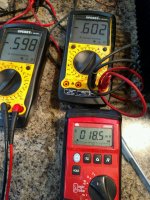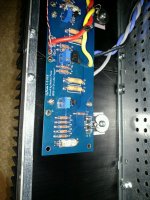answer to #217
I apologize that I wrote that at start up all DMM should show 0.0mV.
You will see very low readings at the speakeroutput (below 50mV),
at the bias resistors should be also very low readings in the mV range (most often
0.0.mV till the MOSFETs come 'alive').
That was confusing flamethrower. Sorry for that!
Your DMMs are good enough to get your amp alive.
Don't bias too high! You know from Mr. Pass not much more than 50 C on the
heatsinks.
And measure the mV over your bias resistors.
Greets
Dirk
I apologize that I wrote that at start up all DMM should show 0.0mV.
You will see very low readings at the speakeroutput (below 50mV),
at the bias resistors should be also very low readings in the mV range (most often
0.0.mV till the MOSFETs come 'alive').
That was confusing flamethrower. Sorry for that!
Your DMMs are good enough to get your amp alive.
Don't bias too high! You know from Mr. Pass not much more than 50 C on the
heatsinks.
And measure the mV over your bias resistors.
Greets
Dirk
Dirk, absolutely no need for any apologies.
All is good and have one channel cooking as we speak.
All is good and have one channel cooking as we speak.
All is good and have one channel cooking as we speak.
Excellent! 😀
Ok, first let me express my extreme gratitude to 6L6 for going far beyond what I have ever imagined anybody would do in my situation.
Hats off to you sir and I owe you a cold one at least, thank you.
Also thanks to the other forum members as well, your help and input is explanatory.
So, the adjustments went good, at least for a first timer.
Pics show the DMMs on both channels.
The one thing that I found though was, you could adjust the pots and within 15 seconds or so of putting the top on, the readings over the resistors would drop to a lower value.
In other words, to get in the .60v range I would have to adjust the pots to .608 or so with the lid off.
Anybody else experience this?
My first thought was that maybe it was steel, I ordered all aluminum and it sure feels like it is aluminum, HMM.
One last check with the two channels hooked up and I am hopefully good to go
Hats off to you sir and I owe you a cold one at least, thank you.
Also thanks to the other forum members as well, your help and input is explanatory.
So, the adjustments went good, at least for a first timer.
Pics show the DMMs on both channels.
The one thing that I found though was, you could adjust the pots and within 15 seconds or so of putting the top on, the readings over the resistors would drop to a lower value.
In other words, to get in the .60v range I would have to adjust the pots to .608 or so with the lid off.
Anybody else experience this?
My first thought was that maybe it was steel, I ordered all aluminum and it sure feels like it is aluminum, HMM.
One last check with the two channels hooked up and I am hopefully good to go
Attachments
The bias has a dependency on temperature so changes with lid on/off is not surprising.
You may need to go through a few iterations to get the bias level you want.
But as long as it's fairly close then I would stop and enjoy the amp.
Cheers,
Dennis
You may need to go through a few iterations to get the bias level you want.
But as long as it's fairly close then I would stop and enjoy the amp.
Cheers,
Dennis
Yes, should have stopped and enjoyed what I had.
Unfortunately being the fricken OCD person I am I decided to re zero one side and see if I could get it closer and smoked a board, NICE.
So not only did I waste some money, I wasted all of your help, I am extremely sorry for that.
What a f@#%ing idiot
Unfortunately being the fricken OCD person I am I decided to re zero one side and see if I could get it closer and smoked a board, NICE.
So not only did I waste some money, I wasted all of your help, I am extremely sorry for that.
What a f@#%ing idiot
Ouch! You actually got the magic smoke out? That hurts. 🙁
At this point, best to just take a break before resuming. Check for parts damage.
If you saw smoke then possibly the output mosfets and some resistors are toast. 🙁
Good thing is that mostly likely the jfets are fine.
Chill a bit...then please take pictures and post.
At this point, best to just take a break before resuming. Check for parts damage.
If you saw smoke then possibly the output mosfets and some resistors are toast. 🙁
Good thing is that mostly likely the jfets are fine.
Chill a bit...then please take pictures and post.
@flamethrower -
🙁 🙁 🙁
We're rooting for you. You'll get it all back up and going in no time. Curse, Pause, Breathe, and then Curse a bit more over a drink. That works well for me at least.
Then we'll look forward to hearing how you progress in swapping out a few parts.
Now I understand your name though. Too soon? 😀
Too soon? 😀
🙁 🙁 🙁
We're rooting for you. You'll get it all back up and going in no time. Curse, Pause, Breathe, and then Curse a bit more over a drink. That works well for me at least.
Then we'll look forward to hearing how you progress in swapping out a few parts.
Now I understand your name though.
 Too soon? 😀
Too soon? 😀Don't beat yourself up. The ridiculous things I've done and that others have shared are pretty comical (in hindsight). It'll be all the sweeter when it's making beautiful music.
Yep those resistors look like they need to be replaced. Others far more skilled than I will certainly chime in with recommendations of proper test procedures to check other parts.
Hopefully it won't nag at you for too long.
Yep those resistors look like they need to be replaced. Others far more skilled than I will certainly chime in with recommendations of proper test procedures to check other parts.
Hopefully it won't nag at you for too long.
So back to 6L6's question. What happened when you smoked it?
(Shorted outputs? Slipped probes?...) This will help with figuring out
the damage.
(Shorted outputs? Slipped probes?...) This will help with figuring out
the damage.
Welcome to the Fearless Amplifier Builder's club. Founding member, N. Pass.
It's fixable. I promise. 🙂 🙂 🙂
It's fixable. I promise. 🙂 🙂 🙂
Hello flamethrower,
what a sh.t! i can't believe it. Because the numbers I see on the pic with the
DMMs were good.
So you had something around 0,6 V = 600mV over the bias resistors and an
offset at the louspeaker of ca. 18 mV. Those numbers are good.
Did the MOSFETs become extremely hot?
Bias resistors are 3W types? Better 5W?
I am with you. I remember my first start up of my first Amp and problems I had.
Don't give up!
First we have to find out 'what went wrong?'
Greets
Dirk
what a sh.t! i can't believe it. Because the numbers I see on the pic with the
DMMs were good.
So you had something around 0,6 V = 600mV over the bias resistors and an
offset at the louspeaker of ca. 18 mV. Those numbers are good.
Did the MOSFETs become extremely hot?
Bias resistors are 3W types? Better 5W?
I am with you. I remember my first start up of my first Amp and problems I had.
Don't give up!
First we have to find out 'what went wrong?'
Greets
Dirk
And I remember from my F5 and F5Turbo-Monoblocks how sensitive they reacted in the upper bias range on the smallest turns of the pots....😱
Greets
Dirk
Greets
Dirk
You may have shorted either side of either resistor (the one you touched with probes to measure the quiescent current) to the ground... with a bit of luck, all you'll need to do is to replace the .47 / 3W resistors and the MOSFETs.
... also, you may have exposed the ZTX's to a high Vbe; so check those as well.
Your wires are soldered onto the PCB from the underside.... they are quite thick and require a lot of heat to solder properly -> this may have burnt the insulation and exposed the wires (underneath)... and they may have touched the heatsink...
Good luck man... keep us posted...
... also, you may have exposed the ZTX's to a high Vbe; so check those as well.
Your wires are soldered onto the PCB from the underside.... they are quite thick and require a lot of heat to solder properly -> this may have burnt the insulation and exposed the wires (underneath)... and they may have touched the heatsink...
Good luck man... keep us posted...
Could be the thermistor short to the washer on the top of the mosfet?
something like NTCALUG02A472G might be better choice.
something like NTCALUG02A472G might be better choice.
That's a nifty part configuration. Thanks for posting that.
Edited to add - @Flamethrower - I have no idea if the thermistor failing and thus shorting could be a potential cause, but there have been a number of conversations around whether the thermistor should touch the package or the washer in such an event. I believe, but cannot be certain, that it's been recommended that the thermistors make contact with the device package itself. If I can find the post (I believe the one I read was from Zen Mod), then I will certainly re-post.
Edited to add - @Flamethrower - I have no idea if the thermistor failing and thus shorting could be a potential cause, but there have been a number of conversations around whether the thermistor should touch the package or the washer in such an event. I believe, but cannot be certain, that it's been recommended that the thermistors make contact with the device package itself. If I can find the post (I believe the one I read was from Zen Mod), then I will certainly re-post.
Last edited:
- Home
- Amplifiers
- Pass Labs
- F5 V3



